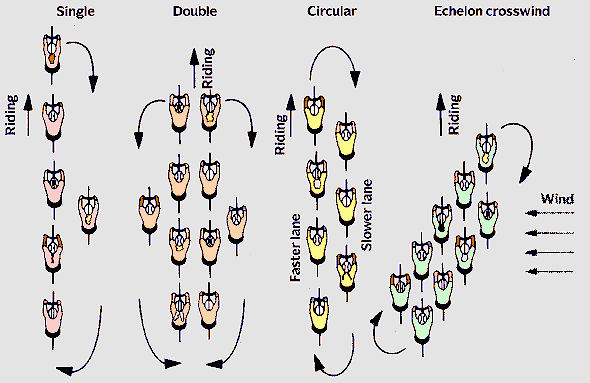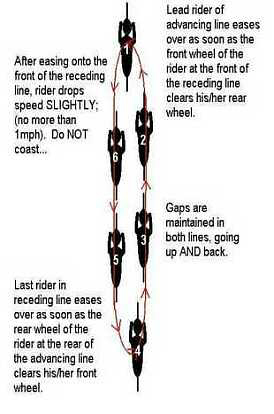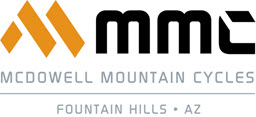Welcome to Part 2 of Group Riding. In Part 1, I wrote about why we ride in groups and how it’s safer and more fun to know and abide by the long-established rules and techniques. This time, I’ll get into the various formations, or pacelines, we use to stay organized.
By drafting off of the front rider(s), the riders behind can save a bunch of energy, upwards of 30-40%. When we share the workload of moving through the wind, we can travel very far, very quickly. In order to move riders around the bunch in an organized way, we need mechanisms for doing so. To move riders to the front and then transfer them to the back again, we use what are called pacelines. To be a proficient group rider you’ll need to know how they work.

The first paceline to master is the single paceline. It’s simply riding single file, so it’s the easiest to get the hang of because there’s nobody next to you and you’re not rotating constantly. In the single paceline, there’s a rider on the front, breaking the wind for the group. That person is also the eyes and ears of the group. That rider will stay on the front for a period of time, usually between 30 seconds to 5 minutes, depending on a lot of factors. When the lead rider is ready to take a break, he or she will pull off into the crosswind, if there is one, and ease up on the gas slightly to slide to the back of the line, taking care to not ease up until off to the side.
A couple notes about being on the front here: first, it’s not advisable to stay on the front until you’re completely gassed, because you’ll need some energy to catch the last rider in the train. If you don’t catch that last rider and lose the draft, your group ride is over, at least until the next regroup point. If you’re not feeling strong, take a shorter pull and come off with something in the tank. Next, if you arrive at the front and don’t WANT to take a pull…too bad. You’ll have to take what we call a token pull, meaning a super short time on the front, and then come off. There’s no going to the back from any other position than the front, so if you have a rider behind you in line, you’re going! The way to avoid taking a pull (and riders may do this for several reasons, like unwrapping an energy bar, messing with their bike, taking off arm warmers or just not feeling up to it) is to leave a gap to the rider in front of you when people come to the back. That’s code for “I’m going to sit on for a while”. In group rides, that’s acceptable; in a race where it’s “game on”, you’ll get a talking to pretty quickly for not doing your share of the work.
Having covered the single paceline, let’s move onto the double paceline, the one you’ll see the most of in group rides. Why? First, it’s social; you can carry on a conversation with someone next to you much more easily than someone behind or in front of you. Also, the law allows us to ride up to 2-abreast, even without a bike lane, although that’s not always safe or smart. The pros have access to the entire road in a race and you’ll see them spread across the whole thing when the pace slows.
The double paceline is simply 2 single pacelines next to each other. Each rider should be riding evenly bar-to-bar, starting with the first two in line. When the first two riders are ready to move to the back, they each move off to their respective outside, cascading out and sliding to the back of the bunch. This will take some coordination. The two riders should come off at the same time, even if one isn’t ready. Whoever is ready to come off the front should say to the other, “Hey, after that guardrail (tree, driveway, etc) up ahead, let’s come off.” The rider nearest the center of the road needs to check for car traffic and make sure they have the space to do so, because you’ll temporarily be 4-abreast until the two riders are back in line at the rear. Same rules apply for taking a pull, a token pull or skipping a pull as in a single paceline. The biggest challenge I see is getting the first two riders to actually ride right next to each other. Many simply want to ride their own pace and get staggered, which throws off the whole group. The pace of the two on the front is always dictated by the slower rider of the two, unless it’s “game on” and time to use tactics, but this article isn’t addressing that. To push the pace of the slower rider next to you is called half-wheeling and it’s uncool. If you want to ride your own pace, go ride by yourself.

Rotating Paceline
The final paceline I’ll get into is my favorite. It’s called a rotating, or circular, paceline and it usually shows up when the pace gets very high so that the work on the front is continuously being exchanged. It’s a single paceline, but instead of a rider sitting on the front for a period of time, the rider on the front comes immediately off and gives the front to the next rider. After one rotation of the group, you’ll have two lines, one constantly moving up and one moving back. Seen from above, it looks like a baggage carousel at an airport. This is an advanced paceline, requiring excellent coordination from all riders and the speeds can get and stay very high. Some common mistakes are getting to the front and surging – no need for that. Getting to the front and staying – come right off as soon as you’re clear of the rider’s front wheel. Coming off and coasting – when you come off, just EASE up on the gas; it’s very subtle. Getting to the back and not being able to catch that last wheel – remember who that last rider is and anticipate having to ratchet up the effort. Rotating downwind in a crosswind – come off the front INTO a crosswind which protects the advancing line from the wind. Leaving gaps, either moving up or moving back – there should never be any gaps in any paceline. And finally, the biggie: crossing wheels; because we’re constantly rotating here, we have to pay close attention to avoid chopping across or undercutting other riders. This one is super fun, but really needs to be experienced to get a feel for how it works.
Finally, there is a variation of these, used during crosswinds, called the echelon. Just like birds in a staggered formation, riders offset their position downwind from the rider in front, because that’s where the least wind resistance is located. It’s very useful in races and is a big tactic used in the Spring Classics, but is of limited use to us because we’re limited in how much road we can and should use. Big echelons take up the entire road and the most we can get away with is 2 riders, maybe 3 with a huge shoulder. However, knowing that in a crosswind the draft is not directly behind the rider in front, but slightly offset downwind IS very useful and can save a lot of energy.
All pacelines are living, breathing entities, and a group proficient in all of them will switch from one to the next as the situation dictates without a word being spoken. Here’s a common example: the group ride rolls out from the coffee shop and starts to warm up. They form up two-by-two and chat and catch up; very relaxed, very social. As everyone gets warmed up and after several exchanges of riders on the front, the group is warm and feeling good and the ride may heat up. As one rider ups the pace more, a gap may form and riders in the slower line slide into the faster line, forming a single paceline. That may go on for a while and then maybe the pace slows and the riders form up in twos again. Maybe a rider jumps hard and breaks away at one point and draws a few riders along, or a few bridge up and join. If they want to stay away from the group, maybe to the finish or a regroup point, they decide to start rotating, to share the load. Now they’re in a rotating paceline. And on it goes…
Time to wrap this up, so I’m going to tackle hand signals and subtle techniques in the next post on group riding. As you can see, it can get pretty involved and may seem intimidating, but don’t let that stop you from giving it a go. Pick a group ride that is controlled and has riders who are willing to impart some wisdom and you’ll be glad you did. Let the ride leader know you’re new to it and a good ride will make sure you’re looked after. Once you’ve seen it and done it a few times, group riding will be a good tool in your bag of tricks as a cyclist, enhancing your experience even when riding with one other person. And those charity rides or gran fondos? Come ride with us and you’ll have those in the bag!
Thanks for reading and I hope to ride with you soon.
Brent
